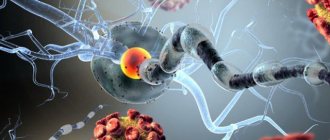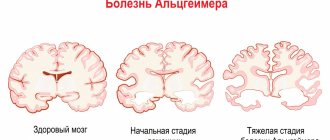Author:
Moroz Anna Andreevna, neurologist, Ph.D.
Quick Transition Treatment of Multiple Sclerosis
Multiple sclerosis (MS) is a chronic autoimmune disease of the central nervous system.
In MS, the central nervous system is damaged. The disease affects the head and spinal cord, but does not affect the nerves of the arms and legs. It is called autoimmune because it is caused by aggression of one’s own immune system.
Causes of multiple sclerosis
There is still no clear understanding of the causes of MS. It is believed that the disease is multifactorial and is caused by a combination of many factors, such as genetic predisposition, geography and ecology of the place of residence, and some viruses. These factors provoke the production of antibodies and facilitate their penetration from the blood into the tissues of the nervous system.
In MS, antibodies attack the myelin sheath of neurons, demyelination of nerve fibers occurs, and signal transmission between neurons is disrupted. The body is able to fight the disease for a long time - the myelin is restored ( remyelination ), and the signal again passes through the fibers. Symptoms appear and disappear; these processes can be observed in almost any part of the brain or spinal cord. The symptoms are dispersed in time and space, which explains the name of the disease.
Masha Runde, 29 years old
Graphic Designer
I learned about my diagnosis in 2013, during my last year at the institute.
In the summer, my arm became numb, my leg began to behave strangely - I thought it was a problem with my spine. I was lucky: at the spine clinic, a young doctor sent me for an MRI, and it immediately became clear what we were faced with. At first it was difficult because you lose what you had. I have gone through all the stages, and it seems to me that acceptance has only just arrived. When I came to the clinic, the doctors groaned and said: “Oh, what a horror, how unlucky your parents are.” I think it was my love of life that pulled me through.
I immediately told my mother about the illness. What's the point of hiding? She took it courageously, we are generally strong.
Something may happen to my body, but I am not only my body.
I don’t like to communicate with my own kind, because many cannot tune in to the fact that you can live with an absent-minded person. I am not a member of any patient groups. I am very empathic and can take on other people’s experiences and try them on myself, and this affects my condition. At the beginning of my illness, I talked to a girl with the same diagnosis, she had difficulty urinating, and I screwed myself up so much that it began to seem like I had the same problems. Since then I decided that I can’t and don’t want to do that. For the same reason, you can’t drag me to meetings of people with MS.
I have interests outside of my illness, and they help me live. I love my job, my friends, my child. In general, my life is not much different from the life of a healthy person. Yes, there are some physical difficulties, but overall this does not interfere with my life. When my husband and I started dating, I already had a diagnosis. I told him it would be difficult, but he was not afraid. Our child, as often happens, “happened” by accident. But it wasn't scary.
When I found out about the pregnancy, I immediately thought that she was about to be born. And I'm very happy. My daughter is like a booster: she gives me the feeling that I definitely have to live, that there is meaning. With her you think less about yourself, there is less time to feel sorry for yourself. Grandmothers don't help us. My position is this: grandmothers have their own children, and this is my child, and I must raise him myself. But my husband, of course, helps in many ways.
I won't say that I am a very responsible patient. At first I nursed my illness. It feels like it was convenient for me, because at any moment I could use it to justify my weakness and laziness. Now I don’t deny it, but I don’t need it to exist.
Illness is not my friend, I don’t drag it around with me - I just live.
I protect myself from stress, take care, love, take care of my health, regularly do MRIs. This is prevention. I haven't had any exacerbations for quite some time. MS is, in essence, auto-aggression: our immunity is trying to “extinguish” us. Therefore, it is necessary to exclude those things that kill in themselves: alcohol, smoking. And add what brings benefit and joy to the body: physical activity, proper nutrition. I think the most important thing for me was to stop self-criticism and to psychologically set myself up correctly.
A mistake that relatives of “scattered people” often make is overprotection. For example, I am strong enough to defend my personal space and say: “My business is my business, and you mind yours.” But many fall into this web: parents try to protect a person from all matters and worries. My grandmother is like this. I ask her for at least some work when I come to her, and she says: “Don’t do anything, don’t cook, I’ll do everything myself, weed the beds.” This is a kind of codependency, the belief that a person will not survive without you.
In fact, resources appear precisely when there is no strong guardianship. I couldn’t walk far for a long time; I felt weak in my legs. Although now I understand that there was a lot of ordinary laziness in this. But when my husband had to go to the hospital and the child had to be taken to kindergarten, strength came from somewhere. And now, when I see that my husband is doing too many things for me, I stop him. Relatives must remember that a person should be allowed to live, not everything taken away from him. When you know that everything will be done for you, there is no desire to strive for something, to do it yourself.
Of course, my mother worries about me. But she doesn't try to do everything for me. She allows me to live and deal with problems on my own. It’s harder for grandma to stop herself: this is the generation of “rescuers.”
When the pandemic began, it was a downfall for many “dispersed people.”
Less walking, less physical activity - that's all. Since then I’ve been scared to go outside, I’m afraid of falling. I live on Taganka, and when I left the house after winter and saw the raised tiles on the sidewalk, my body immediately began to feel chilled, I was afraid of tripping. Now I still go outside and feel how it energizes me! Physical activity is very important, it is stupid to underestimate it. Any activity helps create new neural connections in the brain. Someone will shift all responsibility onto the doctors and say: “That’s it, give me any medicine.” But relying only on medications is not my way.
Of course, I have limitations, I have a disability. In Moscow, there is already a more or less calm attitude towards a limping person, a person in a wheelchair, but not on the periphery. For example, in the village where my grandmother lives, I am a “star”. When all eyes are on me, I feel uncomfortable. This is limiting: you are ashamed of yourself, you don’t want to go out. I get depressed from time to time.
But I like the feeling of being overwhelmed: it gives me time to breathe and think about where to go next. I look for resources in it. I am quite emotional and tend to worry about everyone and everything. And depression is a period when I think only about myself and think through further tactics. I would even say that this is my favorite state.
It seems to me that it is impossible to give any universal advice to people who are sick. We are all different. You should focus on your feelings. You need to go through this whole path of acceptance, turn to a psychologist. In short, you can live. You need to live. Living is important. The main thing is not to write yourself off.
Symptoms
Almost any neurological syndrome manifests itself in MS. It all depends on which area is affected by the antibodies.
Most often observed:
- decreased visual acuity, blurred vision, double vision;
- weakness in the arms and/or legs;
- increased muscle tone (spasticity) in the arms and/or legs;
- numbness of the skin of the face/arms/legs;
- unsteadiness and instability when walking;
- trembling of hands and feet;
- urinary disturbance.
Multiple sclerosis has nothing to do with memory loss; cognitive impairment is not typical for it (the term describes pathomorphological changes).
The disease will not go away, it will stop
Today there are about 2 million people with multiple sclerosis in the world. Every year this number continues to grow, and in large industrial areas and cities the incidence is higher. There are about 150 thousand patients with this diagnosis in Russia. Many people still associate the word “sclerosis” with memory impairment in older people, but “multiple sclerosis” has nothing to do with this. Except, perhaps, for one sad fact: this disease can actually lead to memory loss and other cognitive impairment.
“Multiple sclerosis is a chronic autoimmune disease that occurs when the body's immune system attacks its own neurons and damages the myelin sheath around nerve fibers in various parts of a person's brain and spinal cord. And this disrupts the conduction of electrical impulses in the brain and disorganizes the commutation of all information between different parts of the cerebral cortex. In fact, this is why the disease is called “multiple”, since it affects many parts of the brain. And it is called sclerosis because it leads to sclerosis, that is, scarring of tissue in the brain and the formation of plaques,” says professor, doctor of medical sciences Andrei Bryukhovetsky.
Andrey Bryukhovetsky runs the clinic and has been treating various neurological diseases, including multiple sclerosis, for many years. Bryukhovetsky is convinced: if 20 years ago the diagnosis of “multiple sclerosis” sounded like a death sentence, today medicine has stepped far forward. Yes, it is impossible to completely cure this disease, but there are many ways to stabilize the patient’s condition and stop the course of the disease for a long time.
“We now have a better idea of how the disease develops,” says Denis Korobko, candidate of medical sciences, neurologist at the Regional Center for Multiple Sclerosis and Other Autoimmune Diseases of the Nervous System.
– Due to the fact that there has been a significant breakthrough in understanding the mechanisms of disease development, in the last decade many targeted drugs have appeared that act on certain key points in the disease. The history of treatment for multiple sclerosis began in 1993, when the first drugs for therapy were registered, but they had a bad effect on the immune system. Not so long ago, we began to use drugs that only need to be administered a few times a year for a short course. If the first drugs for the treatment of multiple sclerosis required daily injections and could be accompanied by side effects, then the new group of drugs makes it possible to administer a short course once a year and keep the disease under control for a long time.”
One of the most popular treatments for multiple sclerosis is bone marrow transplantation. This is the process of transplanting a patient’s own hematopoietic stem cells. They are also called hemocytoblasts - these are the earliest precursors of blood cells. Hematopoietic stem cells are present in the red bone marrow, which in turn is found in the cavity of most bones.
“A bone marrow transplant stops the process completely in 50% of cases. I did this 12 years ago. I have patients whom I have been observing for 15-20 years, and their disease does not progress - we managed to stop it,” states Andrei Bryukhovetsky.
On the other hand, there is a group of patients for whom bone marrow transplantation does not help and is even contraindicated, the professor adds.
“We didn’t understand why before. Today, for the first time, we can say that the problem is post-genomic damage to the hematopoietic stem cell. If changes have occurred in the protein structure of this hematopoietic cell, then its descendants can become either immunotolerant, that is, not pay attention to pathologies (as a rule, patients develop tumors), or, conversely, auto-aggressive - they begin to damage their own tissue in different parts of the body . But in both cases these are postgenomic changes. If the cell is not damaged, then transplanting your own healthy ones allows you to restart the entire immune system, and the person is completely restored. I want to say again: the symptoms of the disease will not go away - the progression will end. This is a very important point, because many people think that they will do a bone marrow transplant and that’s it – the disease will go away. The disease will stop: for 15, 20, sometimes even 25 years it stops. We don't know what will happen next. Therefore, it is probably wrong to say “we cured you,” the doctor states.
Fortunately, modern medicine has a fairly wide arsenal of treatment methods, ranging from hormonal therapy to cellular approaches.
“Today we have a fairly large number of modern methods of treating this disease,” says Andrey Bryukhovetsky. – If earlier we managed with hormone therapy, plasmapheresis and plasma exchange, today immunotherapy plays a huge role, people are treated with new generations of drugs. For example, there is a fairly developed pharmacological direction - the use of all kinds of monoclonal antibodies that “knock out” auto-aggressive cells.”
Monoclonal antibodies are a new word in the treatment of multiple sclerosis. These are antibodies produced by immune cells derived from a single progenitor plasma cell. The use of drugs based on them, although it does not solve the problem as much as transplantation, does allow one to achieve long-term remission. However, there are also disadvantages here, the main one being the high cost of treatment, which turns vital procedures into a luxury.
“It’s great, but it’s very expensive,” admits Bryukhovetsky. – The cost of treating patients with multiple sclerosis is somewhere on average for any state at least 7 million rubles. This is the cost of one course! The cost of a course of one of the modern drugs made from monoclonal antibodies is 5,842,000 rubles. In addition, one course is not enough; as a rule, two courses are done once a year.”
However, in Russia today it is possible to get these medications for free. The fact is that multiple sclerosis is included in the list of diseases whose treatment is financed from the federal budget under the “14 high-cost nosologies” program. The list of drugs on the list is constantly updated, making advanced methods of therapy based on monoclonal antibodies available to Russian patients.
However, monoclonal bodies are far from the only method of treating multiple sclerosis. Thus, Andrei Bryukhovetsky admits that he is much more attracted to other, more modern approaches.
“I work mainly with cellular approaches; it seems to me that this is more correct and more promising. In 2005, Academician Yarygin and I visited Professor Oliver Brüstle in Bonn, where he showed us the amazing effectiveness of cell therapy using a model of multiple sclerosis in rats. He used oligodendrocytes (a type of nerve cell - editor's note) from the same animals. The academician and I were just sick of this idea and tried to repeat it. We were able to do this, but since the cells Brustley used were fetal (that is, from a fetus), they were banned in Russia,” said the professor.
Recently, he and colleagues have specialized in the treatment of multiple sclerosis using cell reinfusion. This process involves collecting and reinfusing the patient's own blood.
“Any bone marrow transplant can lead to death in 6-9% of cases. People with multiple sclerosis can live quite a long time, and in some cases the risk is quite unjustified. Therefore, we do a shortened version of this manipulation, calling it “reinfusion of cells against a suppressive background.” We also knock out aggressive cells with monoclonal antibodies, and after that we transplant the body’s own cells and reinfuse them after suppressing their background. This is a very effective method, we have very good results, and most importantly, there is virtually no risk of death,” assures the doctor.
How does multiple sclerosis occur?
Due to remyelination, the disease occurs with exacerbations and remissions for a long time. The above symptoms appear abruptly, but subside over time. As MS develops, symptoms do not completely regress, and a persistent neurological deficit develops.
There are also more severe forms of the disease:
- there is no deterioration and subsequent improvement, a neurological deficit forms immediately and gradually worsens (progressive course);
- demyelination occurs very quickly and affects large areas of the brain (this condition requires immediate treatment as it can be fatal).
Coronavirus and immune memory: how MS occurs
Multiple sclerosis, like many other diseases, begins and progresses differently for everyone. Let's say that some patients have cognitive impairment, while others do not have such problems. As Professor Bryukhovetsky explains, it all depends on in which part of the body the process of sclerosis began.
“It all depends on where the plaque is located. If this is the cortical department and the cortical neurons suffer, then first of all, of course, the brain suffers. If the plaque disrupts the commutation relationships of different parts of the brain, then cognitive function also suffers. Imagine: there are wires, these wires have a braid. This braid is the myelin sheath that covers the axons. If the insulating component disappears, the wires begin to contact each other, that is, the impulse begins to move from one wire to another, and you understand what this can lead to. It all depends on the amount of damage. Therefore, it is not at all necessary that patients with multiple sclerosis will have any intellectual defects,” explains the doctor.
Another fact that is important to know about multiple sclerosis is that it is a neuroinfection. As a rule, they are triggered by neuroinfectious processes: influenza, which we often do not pay attention to and carry on our feet, herpes and, by the way, coronavirus, which today is the most “popular” disease in the world.
“Believe me: now some period of time will pass, and a huge number of patients with demyelinating diseases (a category of diseases of the central nervous system, which includes multiple sclerosis - editor’s note) will be after the coronavirus, because it also has a pronounced neurotropic effect,” explains Bryukhovetsky . – You were sick, suffered from some kind of infectious disease - flu, sore throat, etc. It would seem like something harmless. And suddenly after that you have visual impairment. This is the first and most common symptom of multiple sclerosis. Therefore, we are very afraid of these eye symptoms, they are very bad harbingers. As a rule, they are not noticed. A person goes to an ophthalmologist, who examines him and says: “Yes, everything is fine with you, there’s nothing to worry about!” And the person forgets about this situation. It is then that the phenomena of paresis and paralysis develop.”
The reason for referral to a multiple sclerosis specialist is most often “findings” on MRI, notes Denis Korobko:
“If we talk about the most typical symptoms, these could be: decreased vision, accompanied by pain in the eyes, various disorders of the musculoskeletal system, weakness in the limbs, unsteadiness, “drunk gait,” impaired sensitivity, numbness, dysfunction of the pelvic organs. The patient, as a rule, may first contact a general practitioner or neurologist, who will then refer him for an MRI. Only then does the person see a specialist who treats multiple sclerosis. It is very important to obtain a confirmed diagnosis, because there are many diseases that are similar in MRI indicators, but have a completely different mechanism of development, and therefore different treatment. These can be metabolic, genetic diseases, cardiovascular pathologies.”
Many people believe that multiple sclerosis is inherited. In fact, this disease is based on much more complex, deep-seated processes than we can imagine.
“In this regard, very interesting work was published in March of this year by specialists from the University of Dresden. They proved that the main immune memory of our body is not in peripheral auto-aggressive cells, but in a hematopoietic stem cell. They created a model of infection on a polysaccharide and showed that a polysaccharide bacterial molecule, entering the body for the first time, leaves a trace. So-called enhancer proteins—memory proteins—are formed near DNA. And when our hematopoietic cell encounters this antigen for the second time, it instantly reacts to it, because opposite the DNA there is a mark, a “bookmark”. That is, every infection that we suffer makes many such “bookmarks”. And we carry these “bookmarks” that were passed on to us by previous generations. This is epigenetic structural inheritance. Not the heredity that is in our genome, as is the case with a hereditary disease. This is a hereditary immune memory,” explains Andrey Bryukhovetsky.
Nevertheless, there are from 5 to 7% of familial cases of the disease, notes Denis Korobko. In this regard, he advises never hiding your diagnosis from your relatives, since this knowledge can speed up the process of diagnosing the disease in one of your loved ones.
Another interesting fact (albeit of little comfort for Russia): it turns out that residents of northern latitudes suffer from multiple sclerosis much more often than southerners.
“Northerners are more likely to suffer from multiple sclerosis, this is well known. According to Israeli scientists for 2021, about 3 million people worldwide suffer from multiple sclerosis; in Israel itself there are only about 5 thousand. And mostly this is the North: Great Britain, Sweden, Switzerland. According to the European [Health] Association, almost 2.3 million people there suffer from multiple sclerosis, that is, more than 100 thousand in the UK alone. I say again: multiple sclerosis is primarily a neuroinfection, therefore, like any infections, it is more common among northerners, since they have more colds,” says the professor.
It is worth clarifying that multiple sclerosis itself is no longer the cause of human death. As a rule, the cause of death is complications.
“Previously, death in multiple sclerosis occurred with the addition of some secondary infections, pneumonia, or urinary tract infections. And since today we do not allow side diseases to develop by starting therapy on time, there is no death from multiple sclerosis. In fact, the cause of death may simply be any concomitant diseases, but not multiple sclerosis itself,” assures Denis Korobko.
Treatment of multiple sclerosis
Treatment for MS involves immunomodulation—correction of the immune system.
Exacerbations are treated with hormonal drugs, and in more severe cases, with plasmapheresis aimed at removing antibodies from the blood.
Prevention of exacerbations is carried out with drugs that change the course of multiple sclerosis - DMTs.
Progressive forms of MS require a complex combination of medications, including the use of cytotoxic drugs (slow down or completely stop cell division).
For some manifestations of MS, symptomatic therapy aimed at improving quality of life is possible.
How is multiple sclerosis treated at the Rassvet Clinic?
Neurologists at Dawn must re-interpret (revise) MRI images. This is a fundamentally important point, since there are a number of diseases that mimic MS, but require fundamentally different treatment (neuroinfections, some vascular diseases of the nervous system).
The clinic has a day hospital, which allows patients with exacerbation of the disease to undergo therapy in comfortable conditions. If indicated, botulinum therapy is prescribed to correct spasticity in the limbs. The development of a motor rehabilitation plan, which is extremely important for MS, is carried out with the participation of a rehabilitation specialist.
Diagnostics
In young people with intermittent symptoms, the disease is easily diagnosed. It is more difficult to diagnose with mildly expressed disorders and no signs of damage to the nervous system. Perhaps the first signs of the disease appeared long before going to the doctor, but the patient forgot about them or did not connect them with real manifestations.
Diagnosis of the disease is based on characteristic manifestations:
The first step towards making a diagnosis is a thorough collection of anamnesis and analysis of the information received, a thorough examination and interview of the patient.
The following activities are important:
- Physical examination by a neurologist;
- Blood chemistry;
- Cerebrospinal fluid puncture.
A timely, correct diagnosis contributes to a long, active, fulfilling life for the patient. It is important to immediately consult a doctor when the first symptoms appear.
To diagnose the disease, it is important to consider the following factors:
- The duration of the appearance of signs of multiple sclerosis lasting more than a day with an interval of a month;
- Identification of lesions on MRI.
Additional examination can be carried out to clarify the diagnosis. This could be electromyography or an immunological blood test. Currently, new diagnostic methods make it possible to detect the disease even in children.










